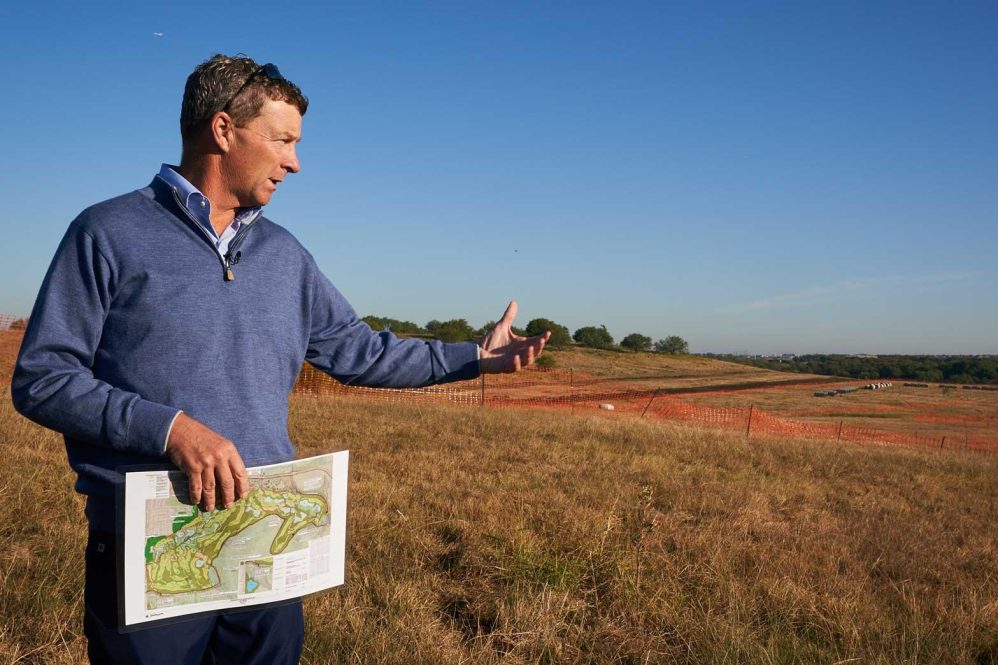Gil Hanse: The Preferred Restorer of Golf Courses
Gil Hanse has established himself as the leading choice for restoring some of the most beloved golf courses globally. His reputation stems from a meticulous approach that emphasizes historical preservation while enhancing playability and aesthetics.
Hanse’s unique ability to merge contemporary techniques with traditional design principles allows him to rejuvenate courses without compromising their original charm. His restoration process often involves thorough research, including examining archival photographs, maps, and course records to ensure fidelity to the original designers’ vision.
A standout project in Hanse’s portfolio is the restoration of the North Course at Los Angeles Country Club. Originally designed by George C. Thomas, this historic course had seen numerous modifications over time. Hanse’s careful restoration not only revived its classic elements but also improved its overall playability.
In addition to Los Angeles Country Club, Hanse has significantly contributed to other prestigious venues such as Oakland Hills Country Club in Michigan and Merion Golf Club in Pennsylvania. These restorations have been lauded for their attention to detail and ability to recapture the essence of these iconic layouts, solidifying his status as a highly respected golf course architect.
The Art of Golf Course Restoration: Gil Hanse’s Precision Approach
- Meticulous Restoration Techniques:
Hanse is celebrated for his detailed methodology in golf course restoration. He prioritizes maintaining original design intentions while integrating modern enhancements that improve both aesthetics and functionality. His team dedicates extensive hours analyzing historical documents and imagery to ensure authenticity throughout each project.
- Revitalizing Iconic Courses:
The scope of Hanse’s work includes some legendary golf courses like The Olympic Club in San Francisco, Baltusrol Golf Club in New Jersey, and Chicago Golf Club in Illinois. His restorations are recognized for their sensitivity towards original designs while creating challenging yet enjoyable experiences for golfers at all skill levels.
- Sustainability Initiatives:
Sustainability plays a crucial role in all of Hanse’s projects; he employs eco-friendly materials and construction practices aimed at minimizing environmental impact. Collaborating closely with local communities ensures that his projects align with regional values and aspirations.
- Cultural Heritage Preservation:
The essence of Hanse’s work transcends mere restoration; it embodies a commitment to preserving golf’s rich heritage. He views historic courses as vital components of our cultural landscape deserving protection for future generations’ enjoyment—his efforts help secure the sport’s legacy well into the future.
Design Philosophy: Merging History with Modernity
Merging History with Modernity: Gil Hanse’s Design Philosophy
Hanse adopts a philosophy that harmonizes historical preservation with contemporary needs, resulting in courses that reflect both past traditions and present-day requirements. He focuses on restoring key features such as greens, bunkers, and fairways while making subtle adjustments aimed at enhancing playability without sacrificing integrity.
A notable example includes his oversight on restoring St Andrews’ Old Course back in 2016—this involved returning it closer to its original layout by Tom Morris while implementing modern improvements like enhanced drainage systems.
Additionally, he has worked on other historic sites such as Winged Foot Golf Club (New York), Merion Golf Club (Pennsylvania), and Royal St George’s (England). Each endeavor required meticulous research alongside collaboration with historians ensuring each course retains its unique character.
Through these efforts not only does he preserve history but also enhances relevance ensuring these treasured venues remain significant within golfing culture moving forward.

Reviving Golf’s Heritage: Why Gil Hanse is the Go-To Restorer for Iconic Courses
Meta Title
Reviving Golf’s Heritage with Gil Hanse: Iconic Course Restorations
Meta Description
Discover how Gil Hanse revitalizes iconic golf courses through restoration, ensuring their heritage lives on while enhancing the golf experience.
The Philosophy Behind Restoration
Understanding the Importance of Heritage
Golf courses are not just venues for play; they are living histories that reflect the evolution of the game. Many iconic courses, designed by legendary architects, require thoughtful restoration to retain their original charm while meeting modern standards. Gil Hanse, a leading figure in golf course restoration, believes in preserving the spirit of these classic designs.
Key Principles of Restoration
- Historical Accuracy: Hanse emphasizes the importance of understanding the original design intentions and maintaining the historical elements of the course.
- Environmental Sustainability: Modern restoration projects incorporate eco-friendly practices, preserving natural landscapes while enhancing playability.
- Player Experience: The design should cater to all skill levels, ensuring that courses remain challenging yet accessible.
Gil Hanse: A Visionary in Golf Course Restoration
Biography and Background
Gil Hanse is an accomplished golf course architect known for his work in restoring historic courses. After earning a degree in landscape architecture, he honed his skills through various projects around the world. Today, Hanse is recognized for his commitment to preserving golf’s rich heritage.
Notable Restorations by Gil Hanse
Hanse has worked on several prestigious projects, reviving iconic golf courses that embody the history and culture of the sport. Some notable restorations include:
| Course Name | Year Restored | Features Enhanced |
|———————-|—————|—————————————-|
| Winged Foot Golf Club| 2016 | Improved bunkering and green complexes |
| Los Angeles Country Club | 2010 | Restored original aesthetics |
| Shinnecock Hills | 2018 | Increased sustainability measures |
Benefits of Golf Course Restoration
Enhancing Playability
Restoring iconic courses offers several benefits:
- Improved Course Conditions: Modern techniques enhance turf quality, drainage, and maintenance practices.
- Varied Gameplay: Restoration often introduces new strategies and challenges, keeping the course fresh for returning players.
Preserving Legacy
By restoring historic courses:
- Historical Significance: Courses retain their historical importance, allowing future generations to appreciate golf’s rich tradition.
- Cultural Value: Restored courses often host significant tournaments, enhancing their status in the golfing community.
Case Study: Winged Foot Golf Club
A Closer Look
Winged Foot Golf Club, located in Mamaroneck, New York, is one of the most prestigious golf courses in the United States. Hanse’s restoration project involved meticulous attention to detail, ensuring the course’s original design was honored.
Restoration Highlights:
- Bunker Design: Restored bunkers were redesigned to reflect their original shapes while improving playability.
- Green Complexes: The greens were enhanced to create more interesting pin placements and increase challenge levels.
Results of the Restoration
The restoration of Winged Foot not only revitalized its aesthetic appeal but also solidified its position as a revered venue for major championships, including the U.S. Open.
Practical Tips for Course Owners Considering Restoration
Assessing the Need for Restoration
- Evaluate Course Condition: Conduct a thorough assessment of the course layout and overall condition.
- Engage with the Community: Involve local golfers and stakeholders to gather input on what aspects of the course should be prioritized.
Choosing the Right Architect
- Research Background: Look for architects with a strong portfolio in restoration, like Gil Hanse.
- Consult References: Speak to former clients about their experience with potential architects.
Planning the Restoration Process
- Set Clear Goals: Define what you want to achieve with the restoration.
- Budget Wisely: Prepare a realistic budget that accounts for unexpected costs during the project.
Leveraging Technology in Restoration
Innovative Techniques
Modern restoration projects benefit from advanced technology:
- 3D Mapping: Allows for precise measurements and analysis of the course layout.
- Soil Analysis: Helps inform decisions on irrigation and turf management strategies.
Continued Maintenance
Post-restoration, implementing technology-driven maintenance practices ensures the course remains in peak condition.
First-Hand Experience: A Golfer’s Perspective
The Impact of Restoration on Gameplay
As a frequent golfer at restored courses, I’ve experienced first-hand the revitalizing effects of thoughtful restoration. Courses often feel more welcoming, with diverse challenges that encourage strategic play.
Memorable Experiences
- Excitement of New Challenges: Each visit reveals subtle changes that keep even veteran players engaged.
- Connection to History: Playing on a restored course evokes a sense of connection to the storied past of golf.
Conclusion: The Future of Golf Course Restoration
With architects like Gil Hanse leading the charge, golf course restoration is not just about preserving history; it’s about enhancing the game’s future. By understanding the delicate balance between preserving heritage and adapting for modern play, Hanse exemplifies the ideal approach to restoring iconic golf courses.
Through careful design and innovative techniques, restored courses will continue to serve as cherished venues for golfers around the world, ensuring that both the legacy and love for the game endure.
Maintaining the spirit of golf while embracing change, restoration projects inspire future generations of players to appreciate the game’s rich heritage.
This structured approach, with SEO-friendly elements and clear sections, ensures that the content is both informative and engaging. Feel free to customize the content, add more case studies, or highlight additional aspects of Gil Hanse’s restoration work as needed!





